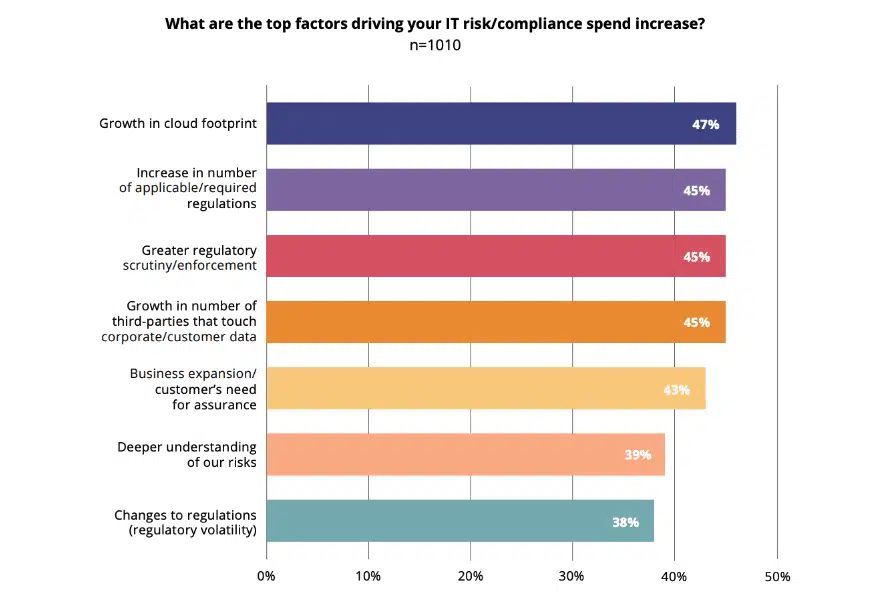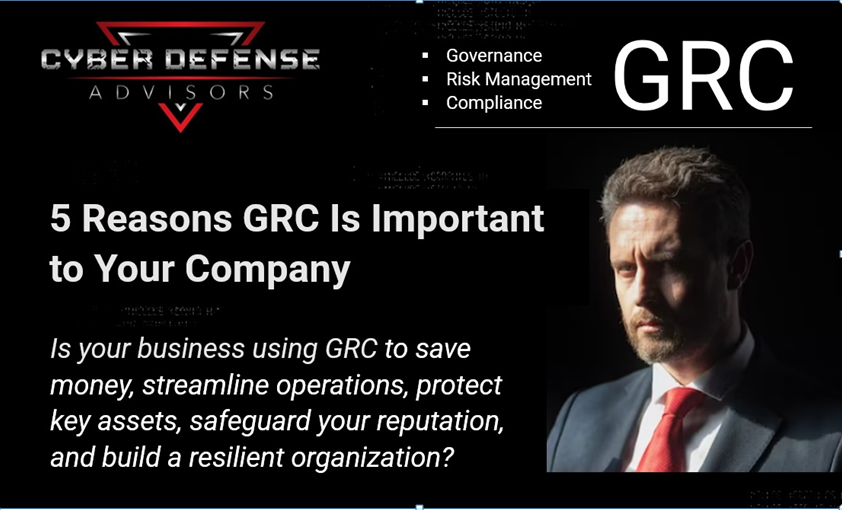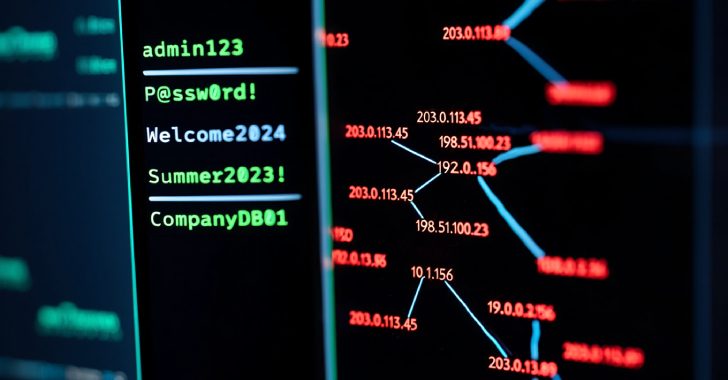Do you want to streamline your IT security budget to handle GRC issues while getting better service for a fraction of the price?
GRC (Governance, Risk Management,Compliance) is aninvaluableprogram companies use to save money, streamline operations, and protect their most valuable assets. More than that, GRC is the foundation of a successful and resilient organization.
Traditionally, mid-sized companies hire at least one employee for each area of GRC; sometimes entire teams are required. These resources typically have limited abilities and expertise, finite experience, and restricted bandwidth. As a company’s needs change and evolve, existing employees are likely unable to handle new or additional regulatory requirements.
Why pay cybersecurity engineers $130k – $170k annually,when these engineers are unable to perform GRC initiatives properly?
Now, imagine if for the same amount of paying just one cybersecurity engineer, you get an entire teamof GRC experts keeping you up-to-date on the classic GRC three-pronged approach. So, for the same price companies traditionally pay for a single dedicated GRC employee, you can now become 100% covered for any and all GRC paths your company may select.
Working with the right partner—CyberDefenseAdvisors.com has been providing GRC services for almost a decade—can afford you the expertise and scalability you need to have proper control over your GRC. This is especially critical in today’s rapidly-changing business environment, where the line between risk and opportunity is often blurred.
The digital software blog Gitnux claims that “a forecasted spending of $47.1 billion on GRC applications by 2023 underscores the massive surge anticipated in the GRC industry.”According to the privacy and security software providerOneTrust, “Cybersecurity, third-party risk, and other policies fall under the GRC domain, with the total software market worth projected to reach $134.86 billion by 2030.”
The chart below highlights key factors driving this exponential GRC growth. Some of these may sound familiar from your own experience as a company leader:

Source: Hyperproof.io
Here are five reasons GRC is important to your company:
1. Establishing a Robust Governance Framework
Governance is all about the way senior executives direct and control their corporations. It is about establishing a method of structuring roles and responsibilities, setting objectives, and ensuring they are achieved. Proper governance promotes fairness, transparency, and accountability, essential attributes for gaining trust from shareholders, employees, customers, and the wider community.
Key Drivers:
- Enhanced Decision Making: Good governance facilitates informed decisions that align with long-term company strategy and stakeholder interests.
- Increased Transparency: Clearly defined roles, responsibilities, and reporting structures lead to transparency in operations.
- Improved Trust: With appropriate governance structures in place, stakeholders develop a higher level of trust in the company.
2. Risk Management: The Protective Shield
Every organizationfaces risks. While some minor risks might be easily manageable, others can threaten the very existence of a company. Risk Management, the second pillar of GRC, is about identifying, assessing, managing, and monitoring these risks.
According to a Hyperproofsurvey, only “33% of respondents said that their companies have made changes to how legal teams work with CISOs in the wake of the Uber data breach verdict.”*Moreover,“51% of respondents say they struggle with identifying where the critical risks are in order to figure out what remediations to prioritize.”
Key Drivers:
- Identifying Vulnerabilities: By continuously identifying and assessing risks, companies can prioritize and allocate resources effectively.
- Enhancing Resilience: Companies equipped with strong risk management frameworks are better prepared to handle unexpected shocks or downturns.
- Opportunistic Approach: Not all risks are negative. Some, when managed correctly, can lead to opportunities. A robust risk management process can help businesses seize these opportunities.
3. Compliance: Navigating the Regulatory Labyrinth
We are living in an era of increasing regulations. From data protection laws to financial regulations, companies must comply with myriad rules. Non-compliance can result in penalties, damaged reputation, and even business shutdown.Nonetheless,Hyperproof’s survey reports that only “57% of all respondents anticipate spending more time on IT risk management and compliance in 2023 vs. 2022.”
Key Drivers:
- Avoiding Penalties: Adhering to compliance helps in avoiding hefty fines and legal troubles.
- Reputation Management: A compliant company is viewed as responsible and ethical in the eyes of its stakeholders.
- Operational Excellence: By ensuring compliance, companies often streamline their processes, which leads to operational efficiency.
4. Synergy of GRC
When Governance, Risk Management, and Compliance operate in silos, it can lead to redundancies, inefficiencies, and missed opportunities. Integrating these functions ensures that the organization operates more holistically and efficiently.
Key Drivers:
- Cost Efficiency: By integrating GRC functions, companies can reduce duplication of efforts and associated costs.
- Consistent Messaging: A unified GRC strategy ensures that all departments and units of the company are aligned in their objectives and communication.
- Proactive Approach: Integrated GRC allows organizations to be proactive rather than reactive, positioning them ahead of potential threats or compliance changes.
5. GRC and Technology
In the digital age, leveraging technology to support GRC efforts has become crucial. Automated GRC platforms offer real-time insights into risks and compliance, allowing companies to be more agile and responsive.PWC attests that, “While internal auditors have been known to act as champions for new risk technologies, adoption is inconsistent; 83% of auditors surveyed felt that their business was slow to adopt the technologies available.”
Key Drivers:
- Scalability: Technology enables GRC efforts to scale in line with company growth.
- Data-Driven Insights: With analytical tools, companies can predict trends and make informed GRC-related decisions.
- Automation: Routine tasks like compliance checks or risk assessments can be automated, ensuring accuracy and efficiency.
Conclusion
In the intricate tapestry of today’s business landscape, GRC plays the role of the threads that hold everything together. While Governance ensures direction and alignment, Risk Management adds resilience and foresight, and Compliance ensures legitimacy and ethical operation.
GRC is the backbone that supports sustainable growth, instills stakeholder confidence, and ensures that the organization remains relevant and resilient in the face of ever-evolving challenges. As the business world becomes more interconnected and complex, the role of GRC will only expand, making it an essential tool for success in the corporate realm.
Partnering with the right firm, such as Cyber Defense Advisors, is critical to the success of implementing your GRC program. Contact us for a free consultation.
Sources:
https://hyperproof.io/resource/purchasing-pattern-trends-in-grc-2023/
https://blog.gitnux.com/grc-industry-statistics/
https://www.onetrust.com/blog/10-grc-trends/
https://www.diligent.com/resources/blog/grc-data
https://www.pwc.com/sg/en/publications/state-of-internal-audit-profession-study-2018.html






